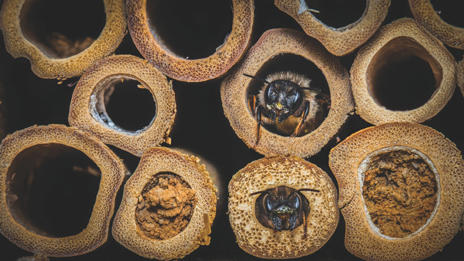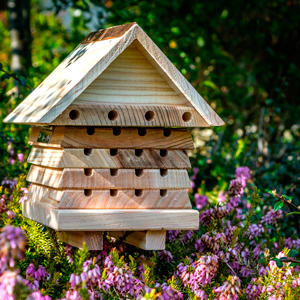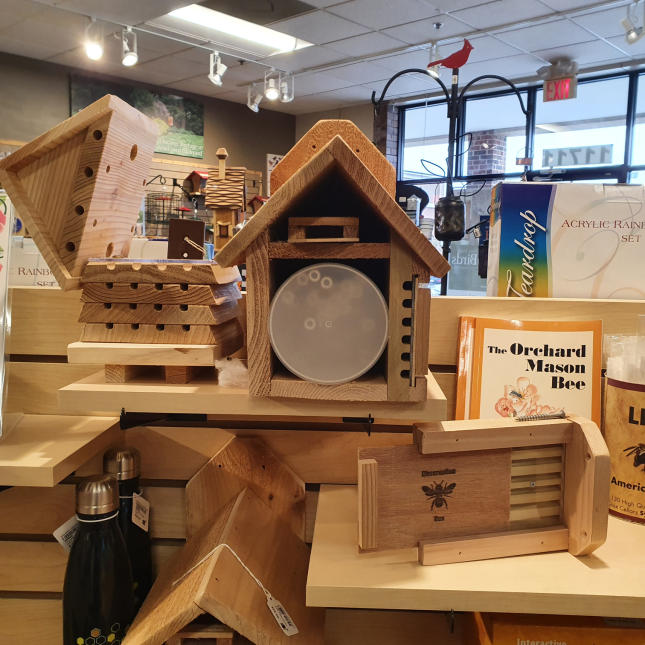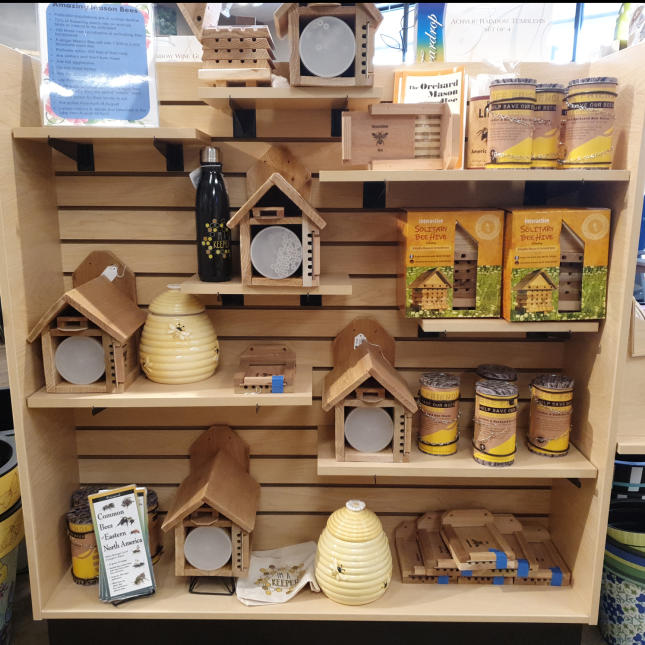
Create a bird-friendly habitat and make a difference for birds.
Think of your yard as a blank slate.
If you could start from scratch, what would be your ultimate landscape design? A classical French garden? An English cottage garden? Or the tried and true suburban turf grass and shrubbery design?
All of these designs can bring style and beauty to your yard, but if your desire is to have a lot of birds and other wildlife as a part of your landscape…they are sure to fail.
So, why not consider a different garden design…a habitat garden! Habitat gardens display all of the beauty and style as the other designs, but they also attract and nurture a much broader variety of wildlife such as bees, butterflies, birds, and amphibians. Most of these function as pollinators. Pollinators help to sustain a healthy environment that supports wildlife, and us, too.
Mason Bees (also known as solitary bees or orchard bees) are amazing native pollinators that you can encourage to live around your home by providing nesting structures and native food resources. We offer a variety of mason bee houses, cocoons, tubes and liners in our showroom.
Kansas City Area list of plants that help attract pollinating bees; https://deeprootskc.org/wp-content/uploads/2019/08/2017_ArduserRecommendedPlantsForAttractingBees.pdf.
Be a Mason Bee Landlord
- Mason bees are among the easiest bees to raise.
- Artificial houses provide a very acceptable nesting location for the female mason bees.
- Mason bee houses are best mounted 6 to 7 feet off the ground to a structure that will not shake in the wind, with the entrance facing towards the east or southeast.
Place the house near flowering plants, as mason bees only fly about 300' in search of nectar and pollen.
Try to install your bee house away from any bird feeders and bird houses
Keep a wet patch of bare soil or offer a plant tray of moist clay within 25' of the mason bee house as available materials for when they construct their brood cells.
To maximize the brood success, some references advise taking down filled nest boxes, and storing them in a dark unheated shed or garage during the winter and returning them outdoors in early spring.
This is to help protect your bees from predators and parasites. Rest assured that the majority of your mason bees will survive is the house is left outside during the winter.
Every mason bee house should be taken apart to clean and sanitize every few years. - Birds and Bees don't always mix, so try not to install your bee house too close to any birdhouses or feeders.
A Year in the Life of A Mason Bee
- The adults emerge from their nest in early spring as the temperature consistently reaches 50-55°F.
- Once the females emerge, they promptly mate, search for cavities that are the right size and shape and go to work stocking their nests.
- Mason bee season is over when the nesting tunnels are capped with mud. This usually happens by early summer.
Pollen and nectar are the favorite foods of their brood - Females collect the pollen, bring it to their tube-like nests, and knead it into pea sized ball, mixing it with nectar and their saliva.
The female lays only one egg in each brood cell and seals it off with a little mud wall.When she completes five to eight cells, she seals the tunnel's entrance hole with a thick mud wall. - Newly laid eggs hatch in approximately one week, with the larvae spending a month or more consuming the pollen ball.
- In early summer, after the feeding period, each larvae spends a week spinning a thick silk cocoon.
- By late summer, mason bees transform into fully-formed adults and remain dormant and safe inside their brood cells throughout the winter.
- Early in the following spring the process repeats itself. The new generation chewing through their cocoon and mud walls to emerge into the world, usually in perfect timing with the early blooming trees, shrubs, and flowers.

Solitary Bee Hive made even better with a opening lid to see inside! The bee nester is constructed in durable FSC certified timber with additional stacking trays which can be opened for inspection and cleaning. Always a friend to the gardener, attracting solitary bees to the garden is not only safe, but beneficial to the pollination of flowers, fruit and vegetables.
The hole sizes of this habitat are precisely specified to attract non-swarming bees like the Red Mason Bee, Leafcutter Bee and other solitary bees. These friendly bees are industrious and safe around children and pets. The bees are naturally attracted to holes in wood and the Interactive solitary beehive provides a habitat that has become harder to find in modern gardens.
Fascinating and great for education, the beehive trays can be carefully separated to view the formation of small cells where the eggs are laid, or indeed where predators have been active.
- NEW FEATURE the roof section flips up to reveal a perspex covered tray, allowing frequent easy monitoring of bee nesting activity and larvae development.
Site in a sunny position facing between south to south east to catch some morning sun. - Mounting height between ground level and 6-7 ft.
- No chemical treatments needed as the habitat is made from durable FSC certified timber
- Stacking trays may be inspected after bee activity has ceased (Autumn/Winter)
- Protect full bee tubes with mesh to prevent predation by woodpeckers
Stop in our showroom to see this and other bee merchandise for your pollinator gardens.


Learn all about Plants for Bees and other Pollinators.

